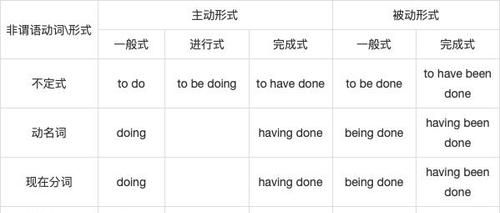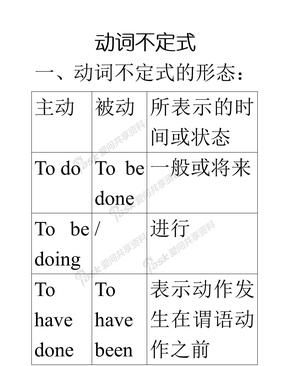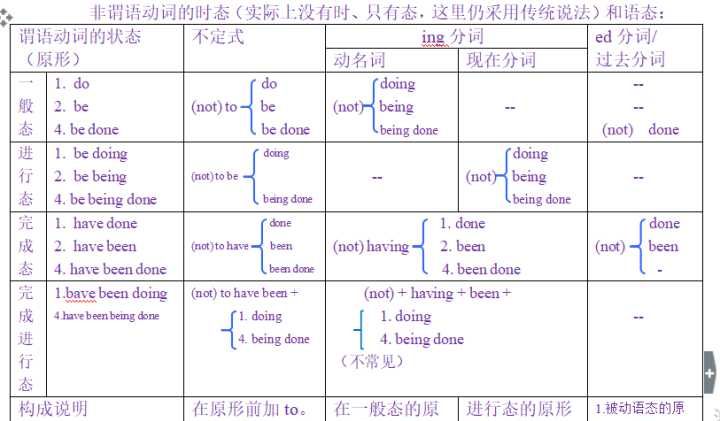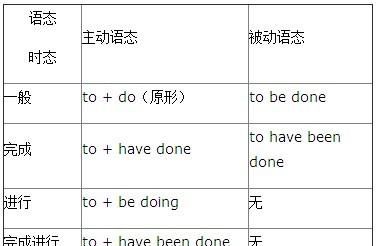本文目录
什么时候用动词不定式
在下列情况下,一般要用不定式: ①hate,like,love前有would(should)时,如:I'd like to have a cup of coffee. ②当谓语动词begin,continue,start等是进行式时,如:Thestudents are starting to work on the di fficult maths problem. ③begin,continue,start与know,understand等状态动词连用时,如:I soon began to understand what was happening. ⒋advise,allow,encourage,forbid,permit等动词后接动名词作宾语,或带不定式作宾语补足语。如: Our teachers don't permit our/us swimming in the lake. Our teachers don't permit us to swim in the lake.

在什么情况下用动词不定式呢
在英语中,用到动词不定式的情况有很多:
在语法中,动词不定式是指动词的一种不带词形变化从而不指示人称、数量、时态的形式。它被叫做不定式,是因为动词不被限定,或者说不被词形变化所局限。不定式属于非谓语动词。
如果动词不定式的逻辑主语是这个不定式所表示的动作的承受者,不定式一般要用被动语态形式。如:
It's a great honour to be invited to Mary's birthday party.不定式作主语是被动语态to be invited是被邀请
It was impossible for lost time to be made up.不定式作主语
I wish to be sent to work in the country.不定式作宾语
Can you tell me which is the car to be repaired?不定式作定语
He went to the hospital to be examined.不定式作状语
在There be结构中,修饰主语的不定式可用被动,也可用主动如:There are still many things to take care of (to be taken care of).但有时两种形式表达的意思不同,如:There is nothing to do now.( We have nothing to do now.) There is nothing to be done now.(We can do nothing now.)
形式
1) 现在式:一般现在时表示的动词,有时与谓语动词表示的动作同时发生,有时发生在谓语动词的动作之后。
He seems to know this.
I hope to see you again. = I hope that I'll see you again. 我希望再见到你。
完成式:表示的动作发生在谓语动词表示的动作之前。
I'm sorry to have given you so much trouble.
He seems to have caught a cold.
进行式:表示动作正在进行,与谓语动词表示的动作同时发生。
He seems to be eating something.
完成进行式:
She is known to have been wreaking on the problem for many years.
一般在表示情绪的动词后加to do也表将来
疑问词
疑问词who,what,which,when,where,whether,how后可接不定式构成不定式短语,在句中作主语、宾语、表 语等。如:
When to leave for London has not been decided yet. 不定式在句子中做主语Mr. Smith didn't know whether to leave or stay there. 不定式在句子中做宾语
I asked Professor Xu how to learn English well. 不定式在句子中做直接宾语
The question was where to get the medicine needed. 不定式在句子中表语)
以上例句中疑问词+不定式部分,均可转换为相应的从句形式。如:When we shall leave…③…how I could learn……
经常在这种结构中使用的动词有:consider,decide,discover,explain,find out,forget,hear,know,learn,observe,understand,wonder等。
作主语
动词不定式作主语时,句子的谓语动词常用单数,其位置有以下两种:
把不定式置于句首。如:
To get there by bike will take us half an hour.
骑自行车到那儿将花费我们半个小时。
To make up for lost time is not possible.
要弥补失去的时光是不可能的。
To lean out of the window is dangerous.
身子探出窗外很危险。
To save money now seems impossible.
现在好像不可能存钱。
用it作形式主语,把真正的主语不定式置于句后,常用于下列句式中。如:
It+be+名词+to do
It's our duty to take good care of the old.
照顾老人是我们的责任。
It takes sb+some time+to do
How long did it take you to finish the work?
你花了多少时间来完成这项工作?
It+be+形容词+for sb+to do
It is difficult for us to finish writing the composition in a quarter of an hour.
我们难以在四分之一小时内完成这篇作文。
It is stupid of you to write down everything (that) the teacher says.
你把老师说的所有东西都记下来的行为是很愚蠢的。
It is an offence to drop litter in the street.在
马路上乱丢废物是违章的。
It seems(appears)+形容词+to do
It seemed impossible to save money.
在句型③中,常用表示客观情况的形容词,如:difficult,easy,hard,important,impossible,necessary 等;
在句型④中,常用careless,clever,good,foolish,honest,kind,lazy,nice,right,silly,stupid,wise等 表示赞扬或批评的词。
在不定式前的sb,可看作其逻辑主语。这一句式有时相当于Sb is+形容词+to do句式 ,如:It's kind of you to help me with my English.=You are kind to help me with my English.
It + 不定式结构可位于believe/consider/discover/expect/find/think和wonder之后
He thought it would be safer to go by train.
他认为乘火车比较安全。
He will find it is hard to make friends.
他会感觉到交朋友困难。
不定式的完成式也可作句子的主语
eg:
To have made the same mistake twice was unforgivable.
两次犯同样的错误是不可原谅的。
It is better to have loved and lost than never to have loved at all.
爱过而后失去了爱,比从未爱过要好。
不定式作为句子成分时,动词用单数形式。
当不定式作主语的句子中又有一个不定式作表语时,不能用It is… to…的句型(对)To see is to believe. 眼见为实 < 正确 >
It is to believe to see. < 错误 >
作宾语
以下动词后,只能跟不定式作宾语
afford (付得起),agree(同意),aim(力求做到),appear(显得),arrange(安排),ask(要求),attempt (试图),care(想要),choose(决定),claim(声称),condescend(屈尊),consent(准许),decide(决定),demand(要求),determine(决心),endeavor(竭力),expect(期待),fail(未履行),help(帮助),hesitate(犹豫),hope(希望),learn(学会),manage(设法),neglect(疏忽),offer(主动提出),plan(计划),prepare(准备),pretend(假装),proceed(接着做),promise(答应),prove(证明),refuse(拒绝),resolve(解决),seem(觉得好像),swear(发誓),tend(往往会),threaten(预示),undertake(承诺),volunteer(自愿做),vow(发誓),want(想要),wish(希望)
eg:
The driver failed to see the other car in time.
司机没能及时看见另一辆车。
I happen to know the answer to your question.
我碰巧知道你那道问题的答案。
动词+疑问词+ 不定式
decide,know,consider forget,learn,remember,show,understand,see,wonder,hear,find out,explain,tell
eg:
Please show us how to do that. 请演示给我们如何去做。
There are so many kinds of tape recorders on sale that I can't make up my mind which to bu.有这么多的录音机,我都拿不定主意买哪一种。
注意:疑问词带不定式在句中作成分时,谓语动词用单数。
The question is how to put it into practice.
问题是怎样把它付诸实施。
3)当复合宾语中的宾语是不定式时,先用形式宾语it代替不定式,把不定式置于补语之后,即:主语+动词+it+补语+to do句式。如:
We think it quite important for us to learn a foreign language well.
He feels it his duty to help the poor.
I find it difficult to learn English well.
作补语
动词+宾语+不定式(to do)
advise allow believe cause challenge compel declare encourage forbid force find hire induce instruct invite like order permit persuade remind request require select send suppose tell train urge
eg:
Father will not allow us to play on the street.
父亲不让我们在街上玩耍。
We believe him to be guilty.
我们相信他是有罪的。
to + be 的不定式结构,作补语的动词。
Acknowledge, believe, consider, think, declare(声称), discover, fancy(设想), feel, find, guess, judge, imagine, know, prove, see(理解), show, suppose, take(以为), understand
eg:
We consider Tom to be one of the best students in our class.
我们认为汤姆是班上最好的学生之一。
to be +形容词
Seem, appear, be said, be supposed, be believed, be thought, be known, be reported, hope, wish, desire, want, plan, expect, mean…
eg:
The book is believed to be uninteresting.
人们认为这本书没什么意思。
there be+不定式
believe,expect,intend,like,love,mean,prefer,want,wish,undrstand
eg:
We didn't expect there to be so many people there.我们没料到会有那么多人在哪里。
有些动词需用as 短语做补语,如regard,think believe,take,consider.
eg:
We regard Tom as our best teacher. 我们认为汤姆是我们最好的老师。
Mary took him as her father . 玛丽把他当作自己的父亲。
秃头不定式作补语
秃头不定式, 即不带“to”的不定式,其语法功能一般在句子中作宾语的补语(宾语补足语)。用秃头不定式作宾语补足语的常用动词如下:
口诀:“五看、三使役“,“两听、一感”要记住,若是“宾补”变“主补”,主补“to”字不能无。动词let属例外,其宾补/主补“to”均无。说明:
五看-----see/watch/notice/observe/look at;三使役-----have/make/let;两听-----hear/listen to;一感-----feel。
eg:
I often see him go to school on foot.(秃头不定式作宾语补足语) He is often seen to go to school on foot.(不定式作主语补足语,要带“to”) Let him try again.---- He is let try again.(let的主补与宾补均用秃头不定式)
Find 特殊用法
Find 后可用分词做宾补,或先加形式宾语,再加形容词,最后加带to 的动词不定式。find后也可带一个从句。此类动词还有get,have。
eg:
I found him lying on the ground.
I found it important to learn.
I found that to learn English is important.

什么时候用动词不定式
动词不定式的用法
动词不定式(to do)是初中英语课本中的一个重点.
动词不定式是由“to+动词原形”构成 (有时可以不带to).其否定形式是“not+动词不定式”(not不与助动词连用).它属于一种非谓语动词的形式,在句子中不能充当谓语,没有人称和数的变化,但它可以保留动词的性质,其本身可以带宾语或状语等附加成分(不定式和其附加成分称为不定式短语).动词不定式(短语)的句法功能非常广泛,在句中可作主语、宾语、补足语、表语、定语及状语等成分.
一、作主语
(1)动词不定式作主语时,谓语动词常常用单数.例如:
To do morning exercises is useful for our health. 做早操有利于我们的健康.
To sweep the floor is my duty every day. 每天打扫地板是我的责任.
(2)如果动词不定式太长,常常用 it 作形式主语,而将真正的主语——动词不定式后置.例如:
It took me half an hour to walk there.我走到那儿花了半小时的时间.
It’s important for us to learn English well.对我们来说,学好英语是重要的.
二、作宾语
(1)能够接动词不定式作宾语的有 ask, agree, beg, decide, determine, fail, hope, manage, offer, plan, prepare, pretend, promise, refuse, wish 及 would like/love 等动词,但 finish, enjoy, miss, appreciate, mind, advise, suggest 等动词后面通常只能接动名词作宾语.例如:
I hope to visit this place again. 我希望能再度访问此地.
She enjoys reading very much.她非常喜欢读书.
The driver failed to see the other car in time. 司机没能及时看见另一辆车.
(2)动词不定式与名等词构成复合宾语时,通常要用 it 作形式宾语,而将真正的宾语——动词不定式后置.例如:
I think it our duty to obey the laws. 我认为遵守法律是我们的义务.
I found it difficult to see him here. 我发现在这里见到他是很难的.
三、作补足语
(1)某些动词在主动式中后接动词不定式作宾语补足语;在被动式中,由于原来的宾语变成了主语,故原来的宾语补足语变成了主语补足语.这类动词常用的有 consider, expect, tell, want, warn, wish,invite等.例如:
They told him not to be late again.他们告诉他不要再迟到了.→He was told not to be late again.
She invited me to have dinner with her yesterday.昨天她请我一起进餐.
(2)在feel(一感),listen to,hear(二听),let,make,have(三让),look at,see,watch,notice(四看)等词之后接不带to的不定式作宾语补足语,强调动作的完成过程;它们作被动句的谓语时,to要补上.如:
I heard her sing today.She sang wonderfully.今天我听见她唱歌了,她唱得非常精彩.
She was heard to sing today.今天有人听见她唱歌了.
She is often heard to sing this song(by us).我们经常听见她唱这首歌.
四、作状语
⑴动词不定式作状语可表示目的、原因及结果等,其逻辑主语就是句子的主语,因此动词不定式作状语往往用主动式.例如:
Come to see me again soon. 尽快再来看我.
I trembled to think of it. 我一想到那件事就不寒而栗.
You couldn't do that to save your life. 你即使为了救自己也不能那样做.
(2) only to do sth. 与 only doing sth. 都可作表示结果的状语,区别是:only to do sth. 表示一个与主语愿望相反的或出乎主语意料的结果, 或用来暗示最初的未能实现的动作;only doing sth. 表示谓语动词本身的动作造成的结果.例如:
I worked hard, only to fail at last. 我努力工作,结果最后却是失败.
He died, only leaving nothing but debts. 他死了,只留下一身债
五、作表语
(1)动词不定式往往放在系动词be(,become, sound, taste 等系动词后面一般不接不定式)的后面作表语,表示将来的情况,说明主语的内容.例如:
My wish is to become a teacher.我的愿望是当一名教师.
Your job today is to clean the playground. 你今天的工作是打扫操场.
(2)如果系动词后的动词说明主语的性质,特征,相当于形容词.这时就要用现在分词作表语,而不用不定式.例如:
He said that the story was interesting.他说这则故事很有趣.
六、作定语
(1)动词不定式常常放在名词或不定代词后面作后置定语,其逻辑主语往往是句子的主语,故动词不定式作定语时往往用主动式;如果动词不定式的逻辑主语不是句子的主语,该动词不定式要用被动式.例如:
Do you have anything to do tonight? 你今晚有什么事要做吗?
I am going to Shanghai tomorrow. Do you have anything to be taken there? 明天我要去上海.你有什么东西要捎去的吗?
(2)动词不定式作定语往往表示尚未发生的动作,如果动作已发生或正在发生,一般用现在分词作定语.例如:
I have no pen to write with.我没有钢笔写字.
The man standing there is Li Ming. 站在那里的那个人是李明.
七、和疑问词连用:
不定式前可用what,who,which,where,when,how,why等疑问词构成不定式短语,这种短语在句子中可作主语、宾语和表语等成分.
(1)作主语.例如:
When to start has not been decided. 什么时候出发还没定下来.
(2)作表语.例如:
The question is how to do the job well. 问题是怎样做好这项工作.
(3)作宾语.例如:
He told me where to find the book. 他告诉我了在哪找到这本书的.
Do you know how to play football? 你知道怎样踢足球吗?
八、不定式的被动式
在初中阶段还涉及到动词不定式被动式的一般式,这种形式是由“to be+动词过去分词”构成的,表示“被……”之意.例如:
There are twenty more trees to be planted. 有更多的树要栽种.

动词不定式什么时候用被动语态
1.以疑问词引导的动词不定式作宾语——注意:不属于宾语从句!
2.少数情况用在将来时be to do sth.意思是:将要做某事,但是各地中考几乎都不考
3.动词不定式作主语、宾语、状语,用作主语时有两种句型:It is +adj.+ to do sth.(it作形式主语)
To do sth. is adj.
有什么错误请原谅

以上就是关于动词不定式在什么情况下使用 ,什么时候用动词不定式的全部内容,以及动词不定式在什么情况下使用 的相关内容,希望能够帮到您。
